Download PDF
Download page Calibrate the Soil Moisture Accounting Basin Model for a Single Water Year.
Calibrate the Soil Moisture Accounting Basin Model for a Single Water Year
Return to Calibrate the Deficit & Constant Basin Model
Last Modified: 2024-09-03 19:46:53.418
HEC-HMS Version
HEC-HMS version 4.12 was used to create this tutorial. You will need to use HEC-HMS version 4.12, or newer, to open the project files.
Project Files
If you are continuing from Calibrate the Deficit & Constant Basin Model for a single water year, you may continue to use your current project files. Otherwise download the initial project files here:
 EF_Russian_River_Task_2_Initial.zip
EF_Russian_River_Task_2_Initial.zip
Step 1: Initialize the Model
This step has been completed for you.
- Open the EF Russian SMA 2005 basin model.
- Prior to calibrating, a model must be initialized with parameter estimates. This model was initialized in like manner to the model presented in Task 1. Soil moisture accounting loss parameters Soil Storage and Maximum Infiltration were estimated based on a Soil Survey Geographic (SSURGO) database (USDA 2015) analysis in GIS. Percent Impervious was estimated from a land use data set analysis in GIS. Initial subbasin loss parameters are presented in Figure 1. Select the Loss tab in the component editor for subbasin EF Russian 20. Soil (%), Groundwater 1 (%), and Groundwater 2 (%) were set to 0 because the simulation begins during an extended dry period for the basin.
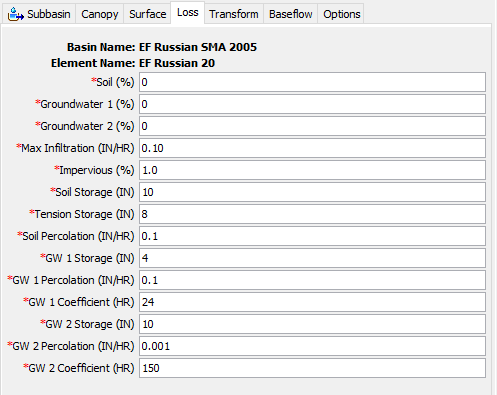
- A simulation run named WY 2005 SMA has been created that incorporates the basin model EF Russian 20 SMA. Run the simulation WY 2005 SMA.
- View the computed vs observed hydrograph at the Calpella Gage junction by browsing to the Results tab in the watershed explorer, expanding the Calpella Gage node and clicking "Graph".
Step 2: Calibrate the Early Wet-Season
- With the initial model run complete, the first focus area for calibration is the early wet-season events. Notice for the first major observed event, the computed results overestimate the runoff response (Figure 2).
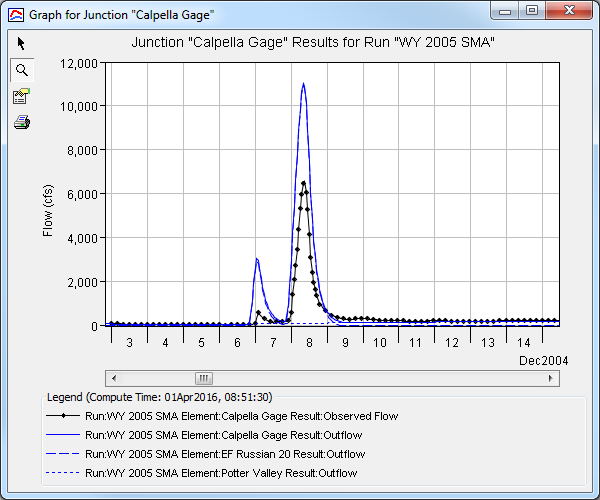
This indicates that losses need to increase in order to decrease the peak runoff. In this case you will focus on increasing infiltration to decrease peak runoff. HEC-HMS provides soil moisture records as output to a simulation run. The "saturation fraction" is particularly useful when adjusting infiltration for the soil moisture accounting loss method. Infiltration starts near the Maximum Infiltration rate and decreases as the saturation fraction increases. This is consistent physically as soil infiltration decreases when the soil becomes saturated. - The best way to visualize the saturation fraction and infiltration for a simulation is by selecting the following results simultaneously (hold ctrl while selecting results). On the Results tab in the watershed explorer, under the EF Russian 20 node, select "Precipitation," "Soil Infiltration," and "Saturation Fraction" and under the Calpella Gage node select "Outflow" and "Observed Flow" (Figure 3). With the results selected in the watershed explorer click the View Graph
 button in HEC-HMS to view results (Figure 4).
button in HEC-HMS to view results (Figure 4).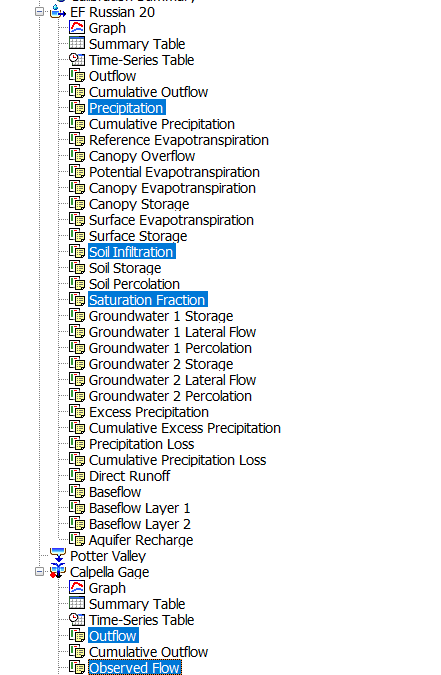
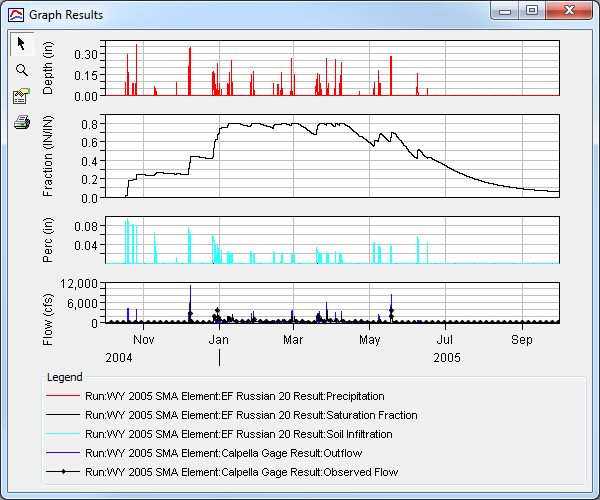
The saturation fraction should approach a maximum at the first major observed runoff event. This occurs when the tension storage is nearly full. The saturation fraction when tension storage is full is tension storage divided by soil storage, or in this example, 0.8. The early wet-season peaks are most sensitive to the Maximum Infiltration parameter. Increasing the Maximum Infiltration will decrease peak flows for early wet-season events and cause soil storage to fill sooner, increasing the saturation fraction. - Adjust the Maximum Infiltration and re-run the model until the computed hydrograph approaches the observed for the first event. The tension zone should also approach capacity at this event (Figure 5).
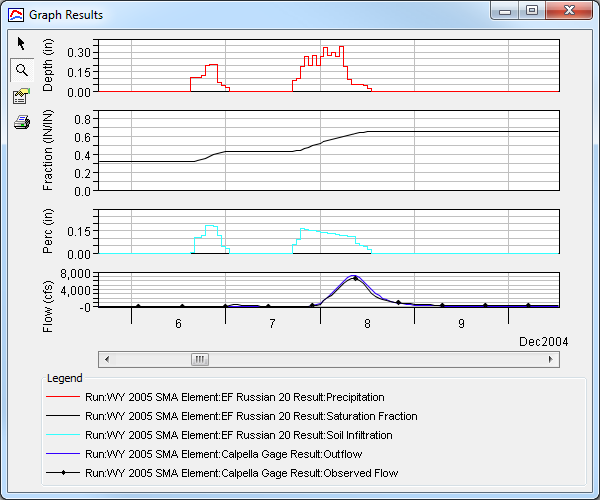
Step 3: Calibrate Wet-Season Events
The next focus area for calibration is wet-season events. Event peaks are regulated by the infiltration rate. When the tension zone is saturated or nearly saturated (e.g. the wet-season), increasing tension storage will increase the average saturation fraction and decrease infiltration. Likewise, decreasing tension storage will decrease the average saturation fraction and increase infiltration.
Adjust the Tension Storage while holding Soil Storage constant and re-run the model until wet-season event peaks approach the observed (Figure 6).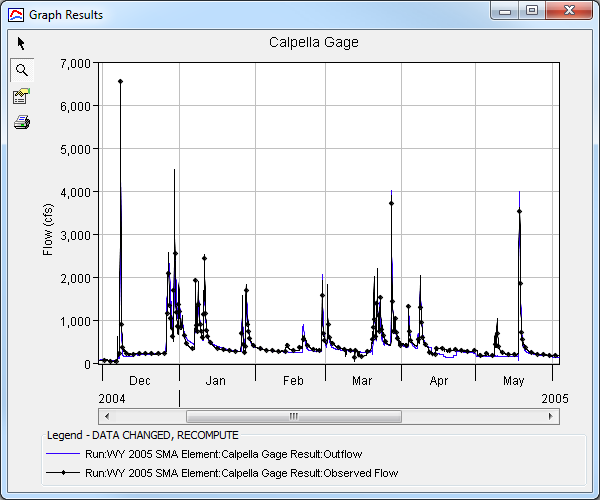
Step 4: Calibrate Baseflow
The next focus area for calibration is the recession limb of hydrographs. The recession limb is important when considering the overall Nash-Sutcliffe Efficiency and the distribution of volume. The recession limb of hydrographs are calibrated by adjusting loss and baseflow parameters when using the soil moisture accounting loss method. Loss parameters include Soil Percolation, GW 1 Storage, GW 1 Percolation, GW 1 Coefficient, GW 2 Storage, GW 2 Percolation, and GW 2 Coefficient. Baseflow parameters include GW 1 Coefficient, GW 1 Reservoirs, GW 2 Coefficient, GW 2 Reservoirs. For this model baseflow parameters have already been calibrated.
Linear Reservoir Baseflow Method Note
When Linear Reservoir Baseflow is used with Soil Moisture Accounting, there is special behavior in the baseflow method. Partition fractions are not used for the Linear Reservoir groundwater 1 and 2 layers because their inflow is determined by the respective lateral outflow from the SMA groundwater layers. However, a partition fraction should be used with the Linear Reservoir groundwater layer 3 in order to define how much percolation from SMA groundwater layer 2 is lost to deep aquifer recharge how much goes towards inflow to the Linear Reservoir groundwater layer 3.
Step 5: Quantify Results
Once calibrated, view summary results (Figure 7) for the "Calpella Gage" junction.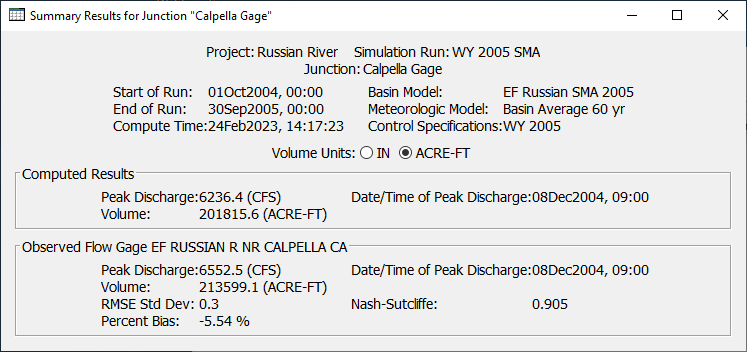
Summary results for calibrated EF Russian 20 DC Basin for simulation WY 2005 SMA are presented in the table below. Results may vary.
| Computed | Observed | |
|---|---|---|
| Peak Discharge (CFS) | 6236.4 | 6552.5 |
| Volume (AC-FT) | 201815.6 | 213599.1 |
The Nash-Sutcliffe Efficiency of the calibrated model is ~0.905. Results may vary.
Final parameters of the calibrated model are presented in the table below. Results may vary.
Element | Parameter | Value |
Canopy | Crop Coefficient | 0.7 |
Loss | Soil Storage (IN) | 10 |
Tension Storage (IN) | 7 | |
Max Infiltration Rate (IN/HR) | 0.35 | |
Soil Percolation (IN/HR) | 0.1 | |
GW 1 Storage (IN) | 4 | |
GW 1 Percolation (IN/HR) | 0.1 | |
GW 1 Coefficient (HR) | 24 | |
GW 2 Storage (IN) | 10 | |
GW 2 Percolation (IN/HR) | 0.001 | |
GW 2 Coefficient (HR) | 150 | |
Transform | Time of Concentration (HR) | 5.5 |
Storage Coefficient (HR) | 4.5 | |
Baseflow | GW 1 Coefficient (HR) | 0.5 |
GW 1 Reservoirs | 1 | |
GW 2 Coefficient (HR) | 24 | |
GW 2 Reservoirs | 1 |
Continue to Calibrate the Deficit and Constant Basin Model to Observed Annual Maximum Flows